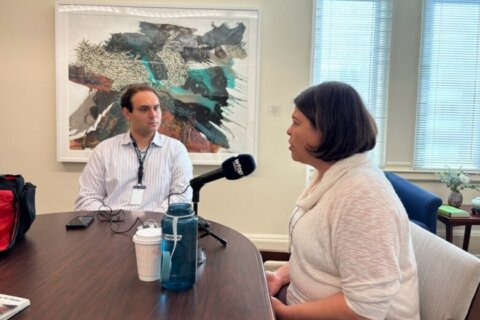
All throughout May, WTOP is celebrating Asian American and Pacific Islander Heritage Month with stories about the people and places shaping the D.C. region.
As a child, one of Nina Albert’s favorite foods was a dehydrated prune.
The dried fruit is salted on the outside. She’d tear the skin off the prune and eat it as if it were candy. She enjoyed the sweet and salty sensation the fruit would provide.
The challenge, Albert said, is the treat is usually only sold in the candy aisle at Asian food markets. Even now, as an adult, Albert searches for one of the 20 different varieties that smaller markets traditionally carry.
Most American grocery stores don’t carry dried fish products either, she said.
Now, as D.C.’s deputy mayor for planning and economic development, Albert is being tasked with revitalizing the city’s Chinatown neighborhood. Part of that could include attracting an Asian grocery store to the neighborhood, something residents have been advocating for.
As a Laotian American, the task presents a unique challenge — preserving the history of the neighborhood while helping it evolve in a way that makes it a destination for residents and visitors.
“We still have a population of Chinese that are in Chinatown and call it their home,” Albert said. “But I think of it more right now as a geographic location that has deep roots in the immigrant story.”
- ‘Let’s eat!’: The role of buffets in AAPI celebrations
- Get a taste of Asian and Pacific Islander cuisine at this Fairfax Co. farmers market
- Purple Patch restaurant an homage to beloved Filipino culture in heart of DC
Albert grew up visiting D.C.’s Chinatown, which included meals at Tony Cheng on H Street. When she worked at WMATA, she’d often visit the neighborhood for food. She and her mom, who is from Laos, would try to get spices in Chinatown that they couldn’t find elsewhere. They’d also search for chopsticks or dinner plates. They did just that about two weeks ago.
D.C.’s Chinatown, Albert said, has “seen various stages of resurgence.” It’s no longer a landing spot for immigrants, but instead provides a gateway to culture. Chinatown’s core, Albert said, is 7th and H streets. The area’s Chinese population is concentrated on the northeast corner, through I Street and Massachusetts Avenue.
In January, about a month after Monumental Sports and Entertainment announced plans to move the Wizards and Capitals to Alexandria, Virginia, Mayor Muriel Bowser launched a task force to determine the evolution of the Gallery Place-Chinatown neighborhood. The teams are remaining in the city, and the task force recently shared a series of visions for how the area can evolve.
Some of the ideas centered on walkable streets, gardens and lawns and ways to improve the fan experience, such as by putting a big screen out in the public to project what’s happening inside Capital One Arena.
After a city presentation last month, some residents called for a more accessible grocery option. The area, Albert said, doesn’t have enough access to produce or meat, “or other kinds of goods that people with an Asian background would expect to have, like mile-long green beans.”
For Albert, Chinatown is about a feeling as much as it is a physical place. The goal, she said, is to embrace the culture beyond the Chinatown gate or Chinese characters on storefront signs. In her eyes, that includes sights, smells and sounds.
“We’re talking about these granular textures,” Albert said. “The color red has a lot of cultural significance throughout Asian culture. It’s one of abundance, luck and fortune.”
City leaders are in the early stages of figuring out which artists they can work with, and how they can create the intimacy that many Asian places bring.
“Physical design can lend itself to preserving, but then how do we layer back in the food, the festivals, and things like culture so that there’s programming, that if people want to learn about Asian American cultures, Chinese culture, that they know that they can go to Chinatown to do it?” Albert said.
It helps to know that Capital One Arena will remain the anchor of the neighborhood, Albert said. For a few months, that wasn’t guaranteed. She had to quickly pivot to how the area can be reimagined without the sports franchises. But that reality was short-lived.
“We’re all focused on how to make the next generation of the Capital One Arena, the physical building, interact much more vibrantly and cohesively with the surrounding area,” Albert said. “Right now, it’s a little bit of a box.”
Albert said that could mean moving an Asian night market to I Street, “so it’s much more intimate.”
As the process evolves, Albert said residents have been vocal about creating housing “that’s priced in a way that people of any income level can afford” and addressing safety concerns. Many have also asked that the city avoid displacing Chinatown residents.
Albert’s mom is largely uninterested in the urban planning side of revitalizing the area. But the two do talk about what Asian spices and foods need to be in the grocery store, for residents and visitors to access.
“When I navigate my role today, I understand that people come at problems or come at solutions, with their own perspectives, often informed by either their parents’ heritage many times or just even their own upbringing,” Albert said. “That’s been a really rich way of approaching this very complex work.”
Get breaking news and daily headlines delivered to your email inbox by signing up here.
© 2024 WTOP. All Rights Reserved. This website is not intended for users located within the European Economic Area.









